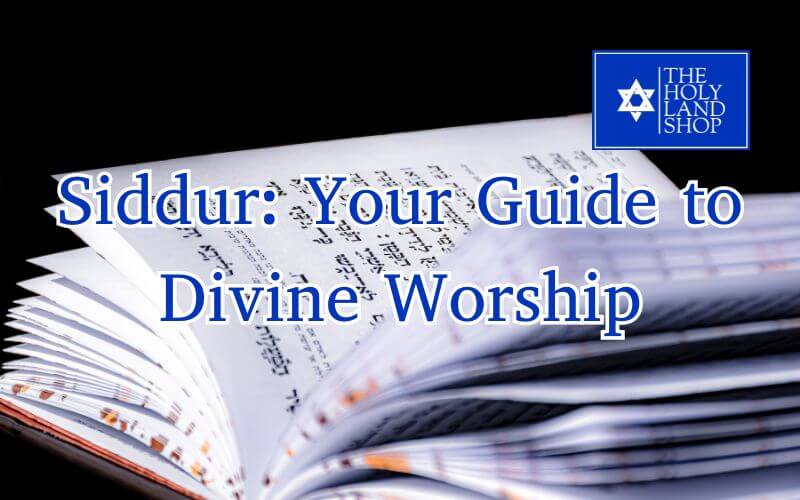The Siddur, or Siddurim in plural, is a Jewish prayer book. It’s a key tool in Jewish worship, guiding the faithful through daily prayers. The Siddur includes a variety of prayers for different times and occasions. It’s used in synagogues and homes, making it central to Jewish religious life.
Across Jewish communities, the Siddur is known by different names. Sephardi Jews call it ‘tefillot,’ while German Jews use ‘tefillah.’ Yemenite Jews refer to it as ‘tiklāl’. Despite the different names, the purpose remains the same: to connect with God through prayer.
Each Siddur is unique, reflecting the traditions of its community. It’s more than a book; it’s a spiritual companion for Jews around the world. Through its pages, the Siddur guides, inspires, and provides a structure for worship. It’s a bridge between the individual and the divine, playing a vital role in Jewish prayer and practice.

Historical Background
The Siddur has a long history, dating back centuries. Its origins are rooted in the early days of Judaism. Initially, Jewish prayers were more fluid, without a fixed format. Over time, rabbis began to compile these prayers. They aimed to create a consistent structure for worship.
As Jewish communities spread across the world, the Siddur evolved. Each community added its own prayers and customs. This led to a variety of Siddurim, each reflecting different Jewish traditions. For example, the prayers and order in a Sephardi Siddur can differ from those in an Ashkenazi one.
Significant changes to the Siddur occurred over different historical periods. The Middle Ages saw considerable development. This was a time when many of the prayers we use today were added. Later, in response to changing times, new versions of the Siddur emerged. They incorporated prayers for contemporary issues and events.
The evolution of the Siddur reflects the dynamic nature of Jewish life. It adapts to the changing needs and circumstances of the Jewish people. Despite these changes, the Siddur remains a unifying factor in Jewish worship. It continues to guide daily prayers and religious rituals, holding a sacred place in Jewish tradition.
Structure and Content
The Siddur is organized to guide Jewish prayers for every occasion. It includes daily prayers, special ones for Shabbat, festivals, and life events. Each section has specific prayers, suited for the time and purpose of worship. This structure helps maintain a rhythm in Jewish prayer life.
Key prayers in the Siddur have deep meanings. The ‘Shema Yisrael’ reminds Jews of God’s oneness. ‘Amidah,’ another central prayer, is a series of blessings. These prayers are fundamental, connecting the worshippers with their faith and heritage.
Different Jewish communities have variations in their Siddurim. Sephardi, Ashkenazi, and Yemenite Jews have distinct traditions. These differences are seen in the choice of prayers and their order. Sephardi Siddurim often include more kabbalistic prayers. Ashkenazi versions might have variations in wording and additional prayers for certain holidays. Yemenite Siddurim, known as Tiklāl, maintain ancient traditions, some dating back to the Temple times.
These variations enrich the Siddur, making it a reflection of the diverse Jewish world. Each community’s prayer book tells a story of its history, culture, and spiritual journey. Yet, all share the common goal of connecting deeply with God through prayer.
The Art of the Siddur
The Siddur is not just a book of prayers; its physical design is an art form. The layout, calligraphy, and artistic elements all have deep significance. Traditionally, the pages are carefully arranged for ease of use during worship. The text is often in Hebrew, with beautiful calligraphy that adds to the spiritual experience.
Artistic elements like illustrations and decorative borders are common in many Siddurim. These designs vary based on the community and era. They often reflect historical and cultural influences. For example, older Siddurim might have intricate, hand-drawn art, while modern ones may include more contemporary designs.
Over time, the design of the Siddur has evolved. In the past, each Siddur was handwritten, making each one unique. With the invention of printing, Siddurim became more uniform and widely available. Today, digital printing allows for personalized designs and layouts.
Despite these changes, the core purpose of the Siddur remains. It’s a sacred tool for prayer, bringing together art, history, and spirituality. The beauty of the Siddur’s design enhances the prayer experience, making it not just a ritual but a deeply aesthetic and spiritual journey.
The Siddur in Daily Life
The Siddur is a daily companion for many Jews. It guides them through prayers in the morning, afternoon, and evening. This regular use deepens their connection to faith and tradition. For many, starting and ending the day with the Siddur brings comfort and focus.
In daily life, the Siddur also appears at special moments. It’s used during Shabbat and holiday services, adding to the sanctity of these times. The prayers within it mark life’s milestones, from celebrations to times of sorrow.
Many people share personal stories about the Siddur. Some recall learning to read from its pages, creating a lifelong bond. Others speak of finding solace in its prayers during tough times. For them, the Siddur is not just a book, but a source of strength and inspiration.
The Siddur also plays a role in family traditions. Parents pass down their favorite prayers to children, creating a bridge across generations. It becomes a symbol of heritage, linking past, present, and future.
In essence, the Siddur is more than a ritual object. It’s a vital part of Jewish spiritual life, offering guidance, comfort, and connection. It stands as a testament to the enduring power of prayer in daily life.
Variations Among Communities
Siddurim vary across Jewish communities, each reflecting unique traditions. Sephardi Siddurim often include prayers with mystical Kabbalistic elements. They feature a distinctive style and order of prayers, influenced by the Sephardi heritage.
Ashkenazi Siddurim, used by Jews of European descent, have different wording and melodies. Their prayers and customs reflect the Ashkenazi history and cultural background. They often include prayers and psalms specific to their traditions.
Yemenite Jews, with their ancient roots, use Siddurim that are close to older practices. Their Siddur, known as Tiklāl, maintains traditions believed to date back to the Temple times. This makes their prayer books unique, preserving ancient Jewish customs.
German Jewish communities, or those following Western European customs, also have their versions of Siddurim. These often combine traditional prayers with influences from their specific cultural context.
The choice and use of these Siddurim are deeply rooted in cultural backgrounds. They reflect the history, language, and customs of each community. This diversity in Siddurim shows the rich tapestry of Jewish life worldwide. It illustrates how different Jewish groups maintain their unique identity while sharing a common bond of faith and prayer.
Modern Adaptations
Modern times have brought changes to the Siddur. Today’s Siddurim often include prayers relevant to contemporary life. These changes reflect the evolving needs and experiences of Jewish communities.
For instance, some modern Siddurim have prayers for the State of Israel. They also include prayers for Holocaust remembrance. These additions make the Siddur more relevant to current generations.
In addition, there are modifications for inclusivity. Some Siddurim now have gender-neutral language. This change addresses the growing diversity within Jewish communities. It allows more people to connect with the prayers personally.
Technology has also influenced the Siddur. Digital versions are now available, making it accessible anytime, anywhere. This adaptation caters to a tech-savvy generation, integrating tradition with modern lifestyles.
These modern adaptations show the Siddur’s flexibility. While it retains its traditional core, it adapts to stay relevant and meaningful. It continues to be a vital tool for Jewish prayer, evolving alongside the people it serves.
Choosing a Siddur
Choosing the right Siddur is important for your spiritual journey. First, think about your Jewish tradition. Whether you’re Sephardi, Ashkenazi, or from another background, pick a Siddur that reflects that. Each tradition has its unique prayers and styles.
Next, consider the language. Many Siddurim come in Hebrew, but there are bilingual options too. If you’re more comfortable with English or another language, look for a Siddur with translations. This can help you understand and connect with the prayers better.
Also, think about the commentary. Some Siddurim offer explanations and insights into the prayers. This can be helpful if you’re looking to deepen your understanding of the prayers.
Size and format are practical aspects to consider. Some prefer a compact Siddur for easy carrying, while others might want a larger print.
If you’re unsure which Siddur to choose, ask for recommendations. Speak with a rabbi or someone knowledgeable in Jewish practices. They can guide you based on your level of observance and interests.
Lastly, take your time with the decision. A Siddur is a personal item that can accompany you for many years. Choose one that resonates with you and your approach to prayer. This way, your Siddur becomes a cherished part of your spiritual life.
Conclusion
The Siddur remains a cornerstone in Jewish tradition and personal spirituality. It’s more than a prayer book; it’s a guide through life’s many moments. The Siddur connects us to our history, community, and God. It’s a source of comfort, inspiration, and reflection.
I encourage you to explore and connect with the Siddur. Whether you’re well-versed or new to Jewish practices, this holy book has something for everyone. Its prayers and teachings can offer new insights and deepen your faith.
I’d love to hear about your experiences with Siddurim. How has the Siddur touched your life? What does it mean to you? Your stories can inspire others and show the Siddur’s impact.
If you’re looking for a Siddur, don’t hesitate to reach out. Whether you need guidance on the right version or help finding one that speaks to you, I’m here to assist. Let’s find a Siddur that resonates with your spirit and journey. Together, let’s embrace the timeless tradition and personal connection the Siddur offers.
